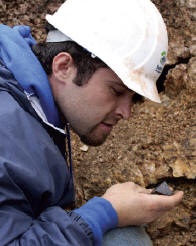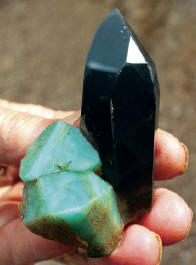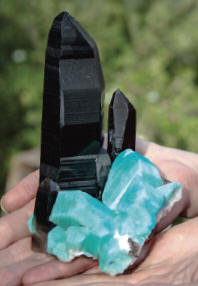Author: Author: Joseph L. DORRIS Date: 2014-9-13 20:34:43

Abraham Velasco recovers first genthelvite in the Crystal Peak area found in side pocket of the Lucky Monday. P5M photo.
The final steps include reassemblingthe matched pieces and permanentlyrepairing the pieces into finespecimens.
LUCKY MONDAY POCKET

4.8 cm genthelvite crystal shown in photo above. J. Scovil photo.
A large pocket discovered on 13June 2011 was dubbed the Lucky Mondaypocket because it was the silver lining to an otherwise, near-disastrousseason. It has proved to be one of themost exceptional pockets discovered inthe 140 years of collecting in the Crystal Peak district. Although other notablepockets have been discovered such as:the Museum Pocket by Thelma Hurianekin 1981, the Keyhole Vug by Don Smith in1986, the Tree Root Pocket by The CollectorsEdge in 1997, and several fromthe Smoky Hawk structure (Majestic,Smithsonian, Poker Chip, The 992), theLucky Monday pocket is exceptional dueto the size of the pocket, the vivid blueand lustrous nature of the amazonite crystals, and the deep black, big and lustroussmoky quartz. Many specimens ofexceptional aesthetics and near-pristinecondition never seen before were producedfrom this pocket.

Second opening of the pocket is showing up. Ch. Borland photo.
The Lucky Monday pocket was ahorseshoe shaped cavity with each sideopening 0.75 m across and penetratingthe wall for 1.5 m. The cavity averaged30 cm in thickness and in some areas, 45cm. Both sides of the shoe contained excellentcombination specimens; however,despite the larger than average numberof good groups, more than half of thepocket had been destroyed by naturalprocesse.

Working in the Lucky Monday pocket, note pegmatite vein. Ch. Borland photo.
As usual, the cavity had rupturedand later collapsed, but sufficient mudand clay helped cushion the ceiling crystalsas well as protect them from subsequentsecondary minerals and oxides.

Freshly collected specimen. J. Dorris photo.
Most of the contents were loose and extractedby hand. After the breakdownwas removed, the top plates were easilypulled free of the pocket clays. The bottomplates were more troublesome andhad to be chiseled free, using pneumaticchisels. About 60 percent of the pocketwas filled with goethite rich clay, hadcrystal contacts of varying degrees, or had been shattered, and produced nosignificant specimens. It took six days tocompletely excavate the pocket and packthe contents, which eventually filled 55flats (a box approximately 10 cm deep by28 cm by 40 cm). Cleaning and piecing togetherthe loose pieces took over a yearand final cleaning and preparation tookanother six months.

Specimens recovered from the pocket. J. Dorris photo.
The result after final preparation ofthe specimens was fourteen large museumquality specimens (over 10 cmplates). The largest specimen, dubbedthe “Porcupine,” measured 32 cm inlength and had seven major smokyquartz crystals reaching to 15 cm and several smaller smoky quartz crystals ona bed of vivid blue amazonite crystals.
Fifteen smaller museum quality specimens,between 7 and 10 cm bases, werealso recovered as well as approximately50 small amazonite groups withoutsmoky quartz. Over 75 single smokyquartz, 5 to 15 cm, and 75 amazonitecrystals, 2 to 5 cm, were also recovered.
The other contents were too damaged toyield specimens but consisted of severalpounds of broken, gem-quality smokyquartz and amazonite rough.
Of particular note, a side pocket wasdiscovered that contained the first genthelvitecrystals ever recovered in theCrystal Peak district. Even more surprising,one crystal was quite large forthe species, almost 5 cm.
MINERAL SPECIES FOUND IN THELUCKY MONDAY POCKET
Albite variety cleavelandite
Cleavelandite is the platy variety ofalbite feldspar. It formed as sparkly, lustrous,euhedral crystal rosettes or lathssurrounding other pegmatite minerals inthe Lucky Monday pocket. The individualblades are a centimeter in length andhave surrounded the bases or filled the contacts between amazonite and smokyquartz crystals in attractive, snow-whitemounds and cushions on a few of thespecimens.
Fluorite
Fluorite occurred in the Lucky Mondaypocket in simple cubic crystal aggregateson top of other pegmatitecrystals as a later-stage mineral. Typicallyin these pockets, the fluorite isetched but displays good luster. Color ispale green and blue green. One largeamazonite and smoky quartz specimenhas a 2 cm elongated fluorite of greenishcolor attached to a smoky quartz prismedge. Other fluorites were detached frommatrix and are not remarkable.

“Two Pillars” after cleaning. P5M photo.









 YueGongAnBei 44051102000467
YueGongAnBei 44051102000467


 |
|